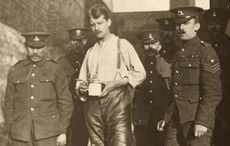More than 100 previously unseen photographs of Irish Aviation from the early 20th century captured in new publication, “Flying with Father Browne.”
Father Francis Browne SJ is now well known as one of the most important Irish photographers of the twentieth century. A Jesuit priest, Father Browne is best-remembered for his extraordinary collection of photographs taken during the maiden voyage of Titanic on which he traveled from Southampton, via Cherbourg, to Cobh. When the Titanic sank, Father Browne’s photographs were printed on the front pages of newspapers around the world.
Read more: Titanic photographer Father Browne’s enchanting album of Dublin
Following the Titanic, Father Browne photographed World War I. He was a decorated chaplain, serving alongside the thousands of Irishmen who joined the British Army. He continued to take photographs throughout his life, amassing a collection of 42,000 negatives which were lost and forgotten, until found by fellow Jesuit, E.E. O’Donnell SJ, the author of this book. Fr O’Donnell was the curator of the Father Browne Collection for many decades.
Read more: “The bravest man I ever met” Father Brown in World War I
Aviation was a source of great fascination for Father Browne. He flew in various aircraft from the early days of flight, often in private planes and in his later years on scheduled aircraft. "Flying with Father Browne" contains his unique images of Irish aviation in the early years of the twentieth century. From the new Dublin Airport to Cobham’s Flying Circus, from early photos of bi-planes to the Aer Lingus fleet, from photographs on the ground to photographs from the air, aviation and photography enthusiasts alike will find here a treasure trove of previously unseen material.
Fr Browne has been favorably compared with the well known French photographer, Henri Cartier-Bresson. Fr Browne's remarkable collection of photographs provide a superb record of the way the Irish lived during the first half of the 20th century. The Irish Times has quoted him as being “the most important documentary historian of this century.”




Comments